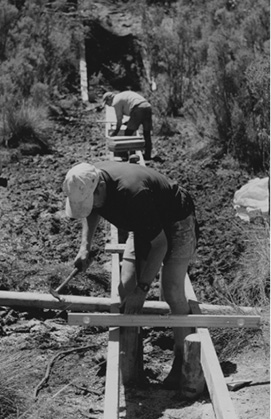26 Towards a New Millennium
In February 1986, three BASE jumpers parachuted down the overhanging east face of Frenchmans Cap. Like the first rock climbers of the early 1960s, BASE jumping introduced a new sphere of adventure and recreation to Frenchmans Cap. The term BASE stands for Building, Antennas, Spans and Earth. It describes the activity of a jumper leaping and free-falling for as long as possible before opening a parachute.
Like rock climbers, BASE jumpers push the limits of their pursuit in a way that is often difficult for ordinary people to understand. ‘The sheer face is 1200 ft high and is the highest in Australia, so is perfect for the leap,’ wrote Simon Wyatt in the Tahune Hut logbook. ‘We mean no harm and hopefully cause none. We also hope no one takes offence at skydivers using a national park, too.’237 ‘Heck, no,’ one bushwalker added, reassuringly. Twelve months later, joined by another three BASE jumpers, the party recorded another 12 jumps. Frenchmans Cap continues to be a popular destination for BASE jumpers.
Track maintenance in the last decades of the 20th Century
WHA dam compensation funds not only reinvigorated Tasmania’s national parks; there were flow-on benefits for the whole state. Much of the quality track work at Frenchmans Cap today was put in place between 1985 and 2005. This was made possible through WHA funding that was part of the dam compensation agreement struck between the state and federal governments.
During this period, track workers at Frenchmans Cap put in a huge effort through sheer dedication and hard work to improve the track. Priority was given to the most environmentally sensitive areas. The injection of WHA funds also allowed the comfort of the huts at Lake Vera and Lake Tahune to be improved.

No more mud. Rangers Rudy Veltuis and Bryan Naylor put boarding in place on the approach to the Loddon River, February 1998. (Terry Reid)
In late 2007, Terry Reid retired as Senior Ranger after over 18 years of service to the PWS. Based at Queenstown Field Centre, his area of responsibility included most of the Wild Rivers National Park, including Frenchmans Cap and the Franklin River. Growing up in Queenstown, his passion for the Frenchmans Cap began as a 16 year-old senior scout when, with three mates, he made his first trip to the region in 1968.
Since then, he has seen the mountain in all its moods — its blinding snowstorms; its simmering heat; its frozen lakes; its torrential rain. Terry Reid has an intimate and unrivalled knowledge of Frenchmans Cap. It is doubtful whether anyone will ever manage to equal the amount of time he has spent in the region: over 40 years of journeys and more than 50 ascents of Frenchmans Cap. A highly practical and logical man, Terry has put his skills at restoring bush huts into practice, not only at Frenchmans Cap but at other locations on the west coast. However, his most important contribution has been in introducing others, particularly young people, to Frenchmans Cap.
Wilderness photography continues to raise public awareness of the value of Tasmania’s wild places. The earlier work of James Beattie, Stephen Spurling III and Frank Hurley has been built on by more recent photographers. Olegas Truchanas, Peter Dombrovskis, Chris Bell, Grant Dixon and Geoffrey Lea have all assembled an impressive body of photographic work depicting Frenchmans Cap. Frenchmans Cap continues to influence and find expression in other forms of art. Environmentalist, artist and printmaker Raymond Arnold has won national and international recognition for his work representing the Tasmanian wilderness. His contemporary art is displayed in leading galleries around the world. Raymond Arnold is based in Queenstown, where he produced his acclaimed etching Imaginary Landscape in 1984. This work captures the grandeur and sweep of Frenchmans Cap in a different way to photography. It shows Frenchmans Cap, Lions Head and the conglomerate ridges that tumble down from the heights above Lake Tahune, collectively, in a hybrid, ‘imaginary’ panorama, as seen from North Col. It is imaginative, thought-provoking and represents several levels of interpretation. Imaginary Landscape is held in the collection of the National Gallery of Australia in Canberra.